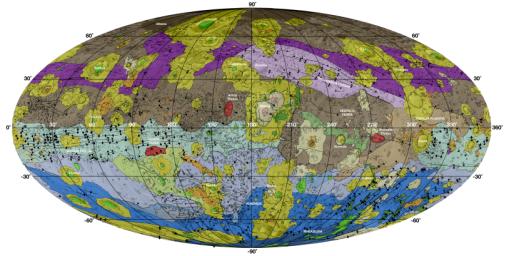Geological Map of Vesta
Caption:
This high-resolution geological map of Vesta is derived from Dawn spacecraft data. Brown colors represent the oldest, most heavily cratered surface. Purple colors in the north and light blue represent terrains modified by the Veneneia and Rheasilvia impacts, respectively. Light purples and dark blue colors below the equator represent the interior of the Rheasilvia and Veneneia basins. Greens and yellows represent relatively young landslides or other downhill movement and crater impact materials, respectively. This map unifies 15 individual quadrangle maps published this week in a special issue of Icarus. Map is a Mollweide projection, centered on 180 degrees longitude using the Dawn Claudia coordinate system.
The legend shows formations and features highlighted on the map. The geological units mapped on Vesta are identified by their appearance in high-resolution images. The place of each unit in Vesta's geologic history comes from careful study of the relative relationship of features. In the legend, Marcian units are younger than Rheasilvian units, which are younger than Veneneian units. The oldest identifiable unit is Vestalia Terra.
Background Info:
JPL manages the Dawn mission for NASA's Science Mission Directorate in Washington. Dawn is a project of the directorate's Discovery Program, managed by NASA's Marshall Space Flight Center in Huntsville, Alabama. The University of California, Los Angeles (UCLA) is responsible for overall Dawn mission science. Orbital Sciences Corp. in Dulles, Virginia, designed and built the spacecraft. The German Aerospace Center, the Max Planck Institute for Solar System Research, the Italian Space Agency and the Italian National Astrophysical Institute are international partners on the mission team.
More information about Dawn is online at
http://www.nasa.gov/dawn
.
Cataloging Keywords:
| Name |
Value |
Additional Values |
| Target |
4 Vesta |
|
| System |
Main Belt |
|
| Target Type |
Asteroid |
|
| Mission |
Dawn |
|
| Instrument Host |
Dawn |
|
| Host Type |
Orbiter |
|
| Instrument |
|
|
| Detector |
|
|
| Extra Keywords |
Color, Crater, Impact, Map |
| Acquisition Date |
|
| Release Date |
2014-11-17 |
| Date in Caption |
|
|
| Image Credit |
NASA/JPL-Caltech/ASU |
| Source |
photojournal.jpl.nasa.gov/catalog/PIA18788 |
| Identifier |
PIA18788 |

 Planetary Data System
Planetary Data System
